Detailed Analysis of Financing Cash Flow for Big Yellow Group PLC
VerifiedAdded on 2022/08/12
|6
|1138
|20
Report
AI Summary
This report analyzes the financing cash flow of Big Yellow Group PLC, focusing on the period's financial activities. It examines the components of cash flow from financing, including the issue of share capital, payments of finance lease liabilities, equity dividend payments, payments to cancel interest rate derivatives, and increases in borrowings. The analysis compares the current year's data with the previous year to highlight trends in the company's financial strategy, such as the increased reliance on equity financing through share issuance and the reduction in borrowings. The report assesses the implications of these changes on the company's financial health and provides a recommendation for investors, considering the company's dividend policy, share price, and overall financial strategy. The analysis is supported by references to financial literature and corporate reports, providing a comprehensive view of the company's financial performance and investment potential.
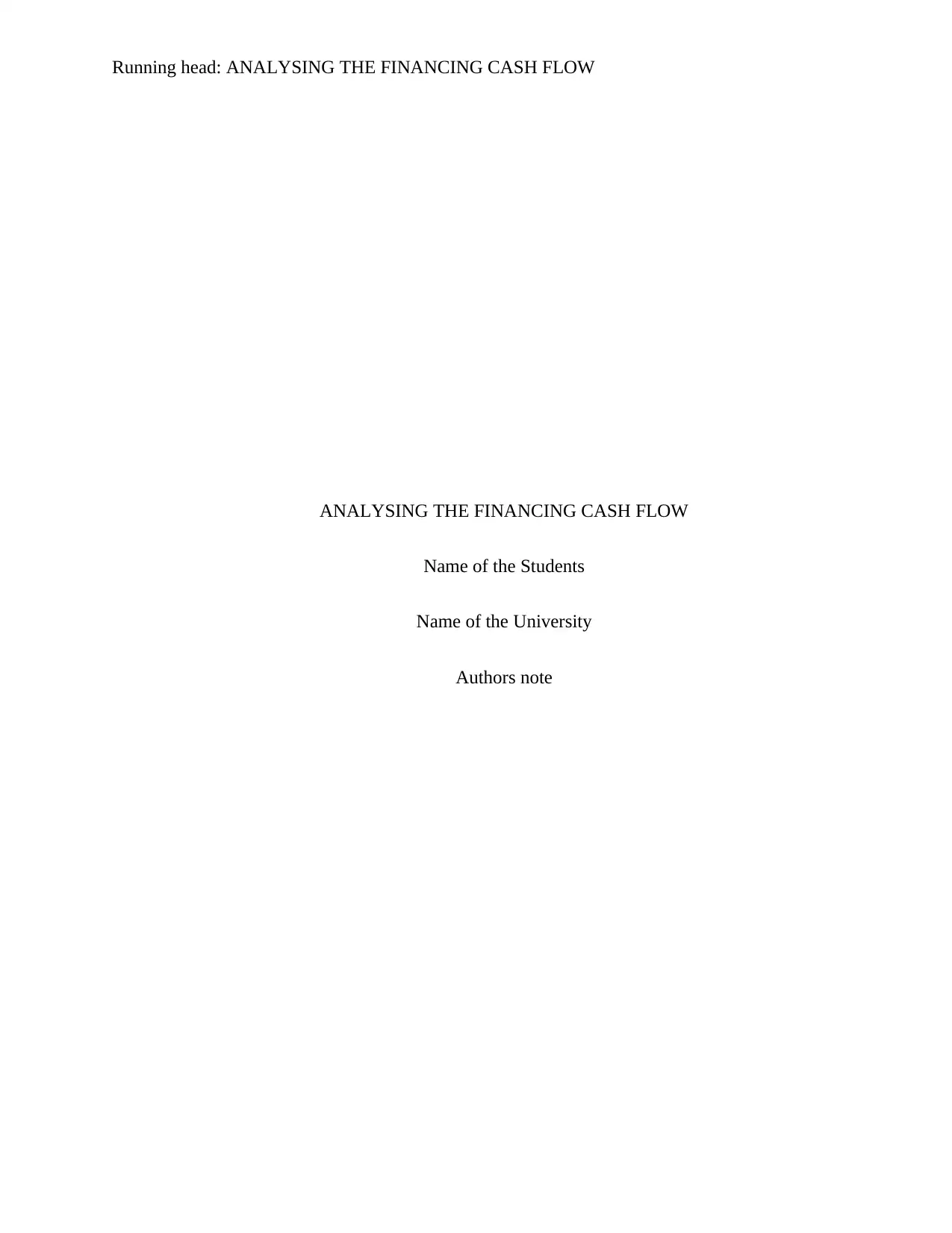
Running head: ANALYSING THE FINANCING CASH FLOW
ANALYSING THE FINANCING CASH FLOW
Name of the Students
Name of the University
Authors note
ANALYSING THE FINANCING CASH FLOW
Name of the Students
Name of the University
Authors note
Paraphrase This Document
Need a fresh take? Get an instant paraphrase of this document with our AI Paraphraser
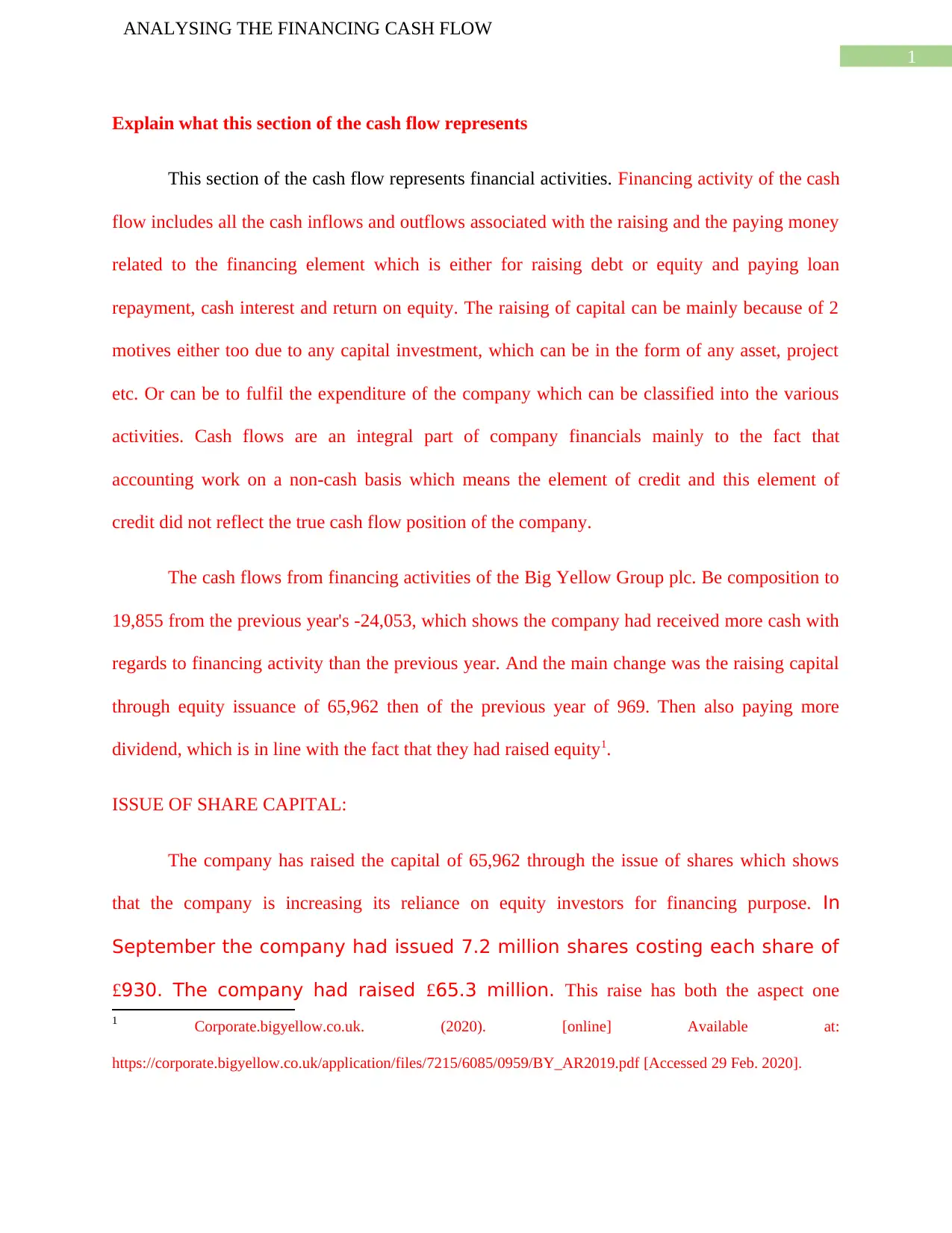
1
ANALYSING THE FINANCING CASH FLOW
Explain what this section of the cash flow represents
This section of the cash flow represents financial activities. Financing activity of the cash
flow includes all the cash inflows and outflows associated with the raising and the paying money
related to the financing element which is either for raising debt or equity and paying loan
repayment, cash interest and return on equity. The raising of capital can be mainly because of 2
motives either too due to any capital investment, which can be in the form of any asset, project
etc. Or can be to fulfil the expenditure of the company which can be classified into the various
activities. Cash flows are an integral part of company financials mainly to the fact that
accounting work on a non-cash basis which means the element of credit and this element of
credit did not reflect the true cash flow position of the company.
The cash flows from financing activities of the Big Yellow Group plc. Be composition to
19,855 from the previous year's -24,053, which shows the company had received more cash with
regards to financing activity than the previous year. And the main change was the raising capital
through equity issuance of 65,962 then of the previous year of 969. Then also paying more
dividend, which is in line with the fact that they had raised equity1.
ISSUE OF SHARE CAPITAL:
The company has raised the capital of 65,962 through the issue of shares which shows
that the company is increasing its reliance on equity investors for financing purpose. In
September the company had issued 7.2 million shares costing each share of
£930. The company had raised £65.3 million. This raise has both the aspect one
1 Corporate.bigyellow.co.uk. (2020). [online] Available at:
https://corporate.bigyellow.co.uk/application/files/7215/6085/0959/BY_AR2019.pdf [Accessed 29 Feb. 2020].
ANALYSING THE FINANCING CASH FLOW
Explain what this section of the cash flow represents
This section of the cash flow represents financial activities. Financing activity of the cash
flow includes all the cash inflows and outflows associated with the raising and the paying money
related to the financing element which is either for raising debt or equity and paying loan
repayment, cash interest and return on equity. The raising of capital can be mainly because of 2
motives either too due to any capital investment, which can be in the form of any asset, project
etc. Or can be to fulfil the expenditure of the company which can be classified into the various
activities. Cash flows are an integral part of company financials mainly to the fact that
accounting work on a non-cash basis which means the element of credit and this element of
credit did not reflect the true cash flow position of the company.
The cash flows from financing activities of the Big Yellow Group plc. Be composition to
19,855 from the previous year's -24,053, which shows the company had received more cash with
regards to financing activity than the previous year. And the main change was the raising capital
through equity issuance of 65,962 then of the previous year of 969. Then also paying more
dividend, which is in line with the fact that they had raised equity1.
ISSUE OF SHARE CAPITAL:
The company has raised the capital of 65,962 through the issue of shares which shows
that the company is increasing its reliance on equity investors for financing purpose. In
September the company had issued 7.2 million shares costing each share of
£930. The company had raised £65.3 million. This raise has both the aspect one
1 Corporate.bigyellow.co.uk. (2020). [online] Available at:
https://corporate.bigyellow.co.uk/application/files/7215/6085/0959/BY_AR2019.pdf [Accessed 29 Feb. 2020].
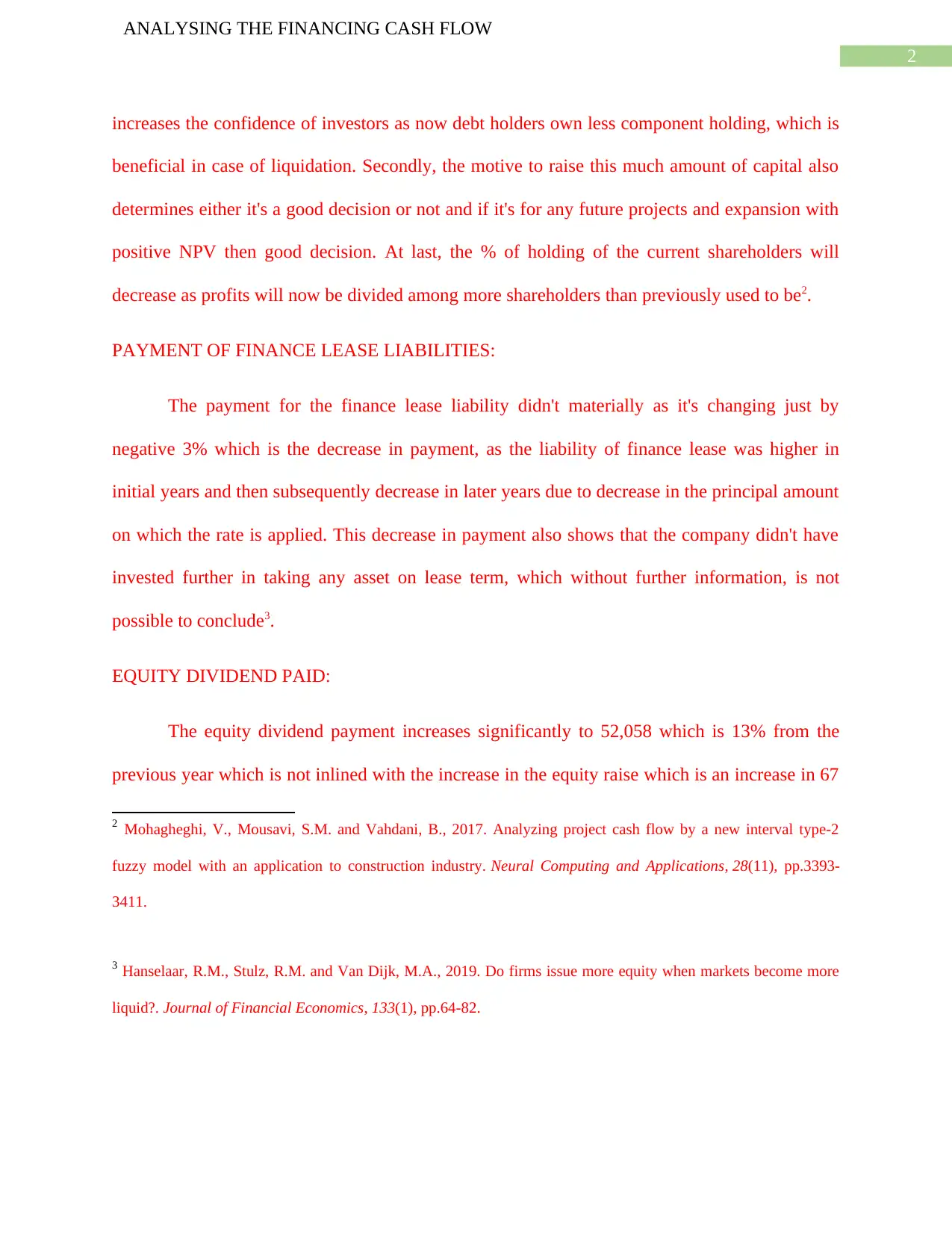
2
ANALYSING THE FINANCING CASH FLOW
increases the confidence of investors as now debt holders own less component holding, which is
beneficial in case of liquidation. Secondly, the motive to raise this much amount of capital also
determines either it's a good decision or not and if it's for any future projects and expansion with
positive NPV then good decision. At last, the % of holding of the current shareholders will
decrease as profits will now be divided among more shareholders than previously used to be2.
PAYMENT OF FINANCE LEASE LIABILITIES:
The payment for the finance lease liability didn't materially as it's changing just by
negative 3% which is the decrease in payment, as the liability of finance lease was higher in
initial years and then subsequently decrease in later years due to decrease in the principal amount
on which the rate is applied. This decrease in payment also shows that the company didn't have
invested further in taking any asset on lease term, which without further information, is not
possible to conclude3.
EQUITY DIVIDEND PAID:
The equity dividend payment increases significantly to 52,058 which is 13% from the
previous year which is not inlined with the increase in the equity raise which is an increase in 67
2 Mohagheghi, V., Mousavi, S.M. and Vahdani, B., 2017. Analyzing project cash flow by a new interval type-2
fuzzy model with an application to construction industry. Neural Computing and Applications, 28(11), pp.3393-
3411.
3 Hanselaar, R.M., Stulz, R.M. and Van Dijk, M.A., 2019. Do firms issue more equity when markets become more
liquid?. Journal of Financial Economics, 133(1), pp.64-82.
ANALYSING THE FINANCING CASH FLOW
increases the confidence of investors as now debt holders own less component holding, which is
beneficial in case of liquidation. Secondly, the motive to raise this much amount of capital also
determines either it's a good decision or not and if it's for any future projects and expansion with
positive NPV then good decision. At last, the % of holding of the current shareholders will
decrease as profits will now be divided among more shareholders than previously used to be2.
PAYMENT OF FINANCE LEASE LIABILITIES:
The payment for the finance lease liability didn't materially as it's changing just by
negative 3% which is the decrease in payment, as the liability of finance lease was higher in
initial years and then subsequently decrease in later years due to decrease in the principal amount
on which the rate is applied. This decrease in payment also shows that the company didn't have
invested further in taking any asset on lease term, which without further information, is not
possible to conclude3.
EQUITY DIVIDEND PAID:
The equity dividend payment increases significantly to 52,058 which is 13% from the
previous year which is not inlined with the increase in the equity raise which is an increase in 67
2 Mohagheghi, V., Mousavi, S.M. and Vahdani, B., 2017. Analyzing project cash flow by a new interval type-2
fuzzy model with an application to construction industry. Neural Computing and Applications, 28(11), pp.3393-
3411.
3 Hanselaar, R.M., Stulz, R.M. and Van Dijk, M.A., 2019. Do firms issue more equity when markets become more
liquid?. Journal of Financial Economics, 133(1), pp.64-82.
⊘ This is a preview!⊘
Do you want full access?
Subscribe today to unlock all pages.

Trusted by 1+ million students worldwide
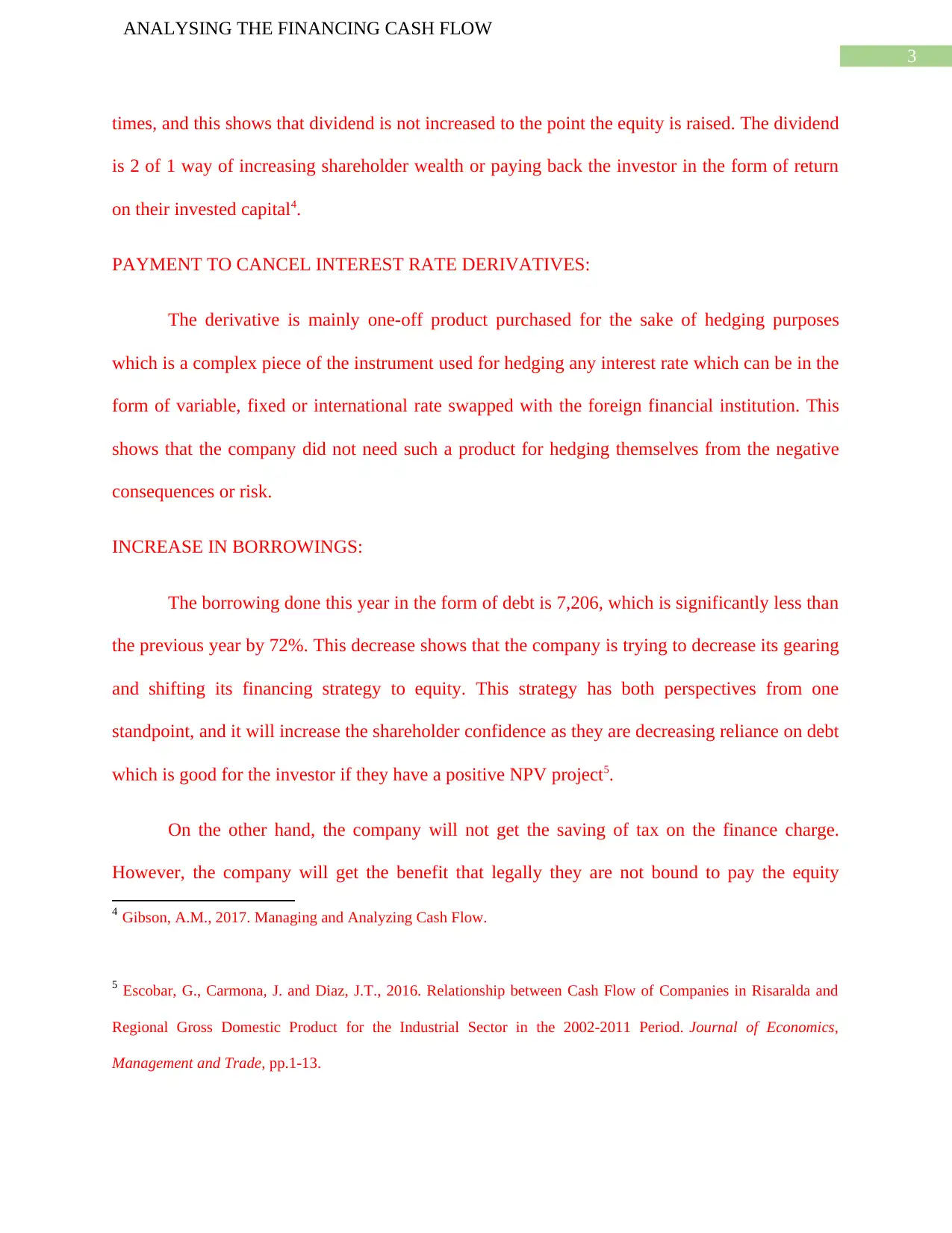
3
ANALYSING THE FINANCING CASH FLOW
times, and this shows that dividend is not increased to the point the equity is raised. The dividend
is 2 of 1 way of increasing shareholder wealth or paying back the investor in the form of return
on their invested capital4.
PAYMENT TO CANCEL INTEREST RATE DERIVATIVES:
The derivative is mainly one-off product purchased for the sake of hedging purposes
which is a complex piece of the instrument used for hedging any interest rate which can be in the
form of variable, fixed or international rate swapped with the foreign financial institution. This
shows that the company did not need such a product for hedging themselves from the negative
consequences or risk.
INCREASE IN BORROWINGS:
The borrowing done this year in the form of debt is 7,206, which is significantly less than
the previous year by 72%. This decrease shows that the company is trying to decrease its gearing
and shifting its financing strategy to equity. This strategy has both perspectives from one
standpoint, and it will increase the shareholder confidence as they are decreasing reliance on debt
which is good for the investor if they have a positive NPV project5.
On the other hand, the company will not get the saving of tax on the finance charge.
However, the company will get the benefit that legally they are not bound to pay the equity
4 Gibson, A.M., 2017. Managing and Analyzing Cash Flow.
5 Escobar, G., Carmona, J. and Diaz, J.T., 2016. Relationship between Cash Flow of Companies in Risaralda and
Regional Gross Domestic Product for the Industrial Sector in the 2002-2011 Period. Journal of Economics,
Management and Trade, pp.1-13.
ANALYSING THE FINANCING CASH FLOW
times, and this shows that dividend is not increased to the point the equity is raised. The dividend
is 2 of 1 way of increasing shareholder wealth or paying back the investor in the form of return
on their invested capital4.
PAYMENT TO CANCEL INTEREST RATE DERIVATIVES:
The derivative is mainly one-off product purchased for the sake of hedging purposes
which is a complex piece of the instrument used for hedging any interest rate which can be in the
form of variable, fixed or international rate swapped with the foreign financial institution. This
shows that the company did not need such a product for hedging themselves from the negative
consequences or risk.
INCREASE IN BORROWINGS:
The borrowing done this year in the form of debt is 7,206, which is significantly less than
the previous year by 72%. This decrease shows that the company is trying to decrease its gearing
and shifting its financing strategy to equity. This strategy has both perspectives from one
standpoint, and it will increase the shareholder confidence as they are decreasing reliance on debt
which is good for the investor if they have a positive NPV project5.
On the other hand, the company will not get the saving of tax on the finance charge.
However, the company will get the benefit that legally they are not bound to pay the equity
4 Gibson, A.M., 2017. Managing and Analyzing Cash Flow.
5 Escobar, G., Carmona, J. and Diaz, J.T., 2016. Relationship between Cash Flow of Companies in Risaralda and
Regional Gross Domestic Product for the Industrial Sector in the 2002-2011 Period. Journal of Economics,
Management and Trade, pp.1-13.
Paraphrase This Document
Need a fresh take? Get an instant paraphrase of this document with our AI Paraphraser
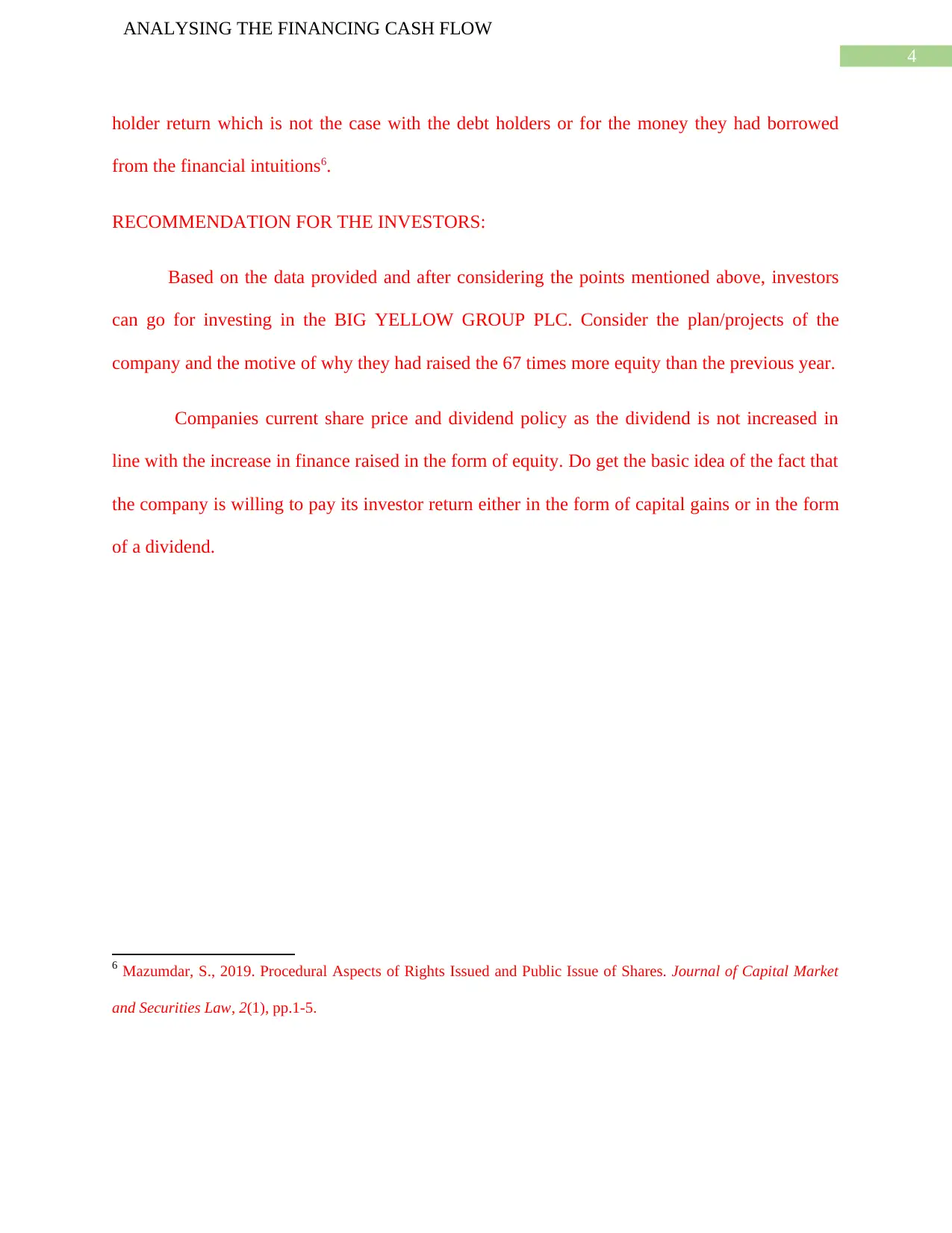
4
ANALYSING THE FINANCING CASH FLOW
holder return which is not the case with the debt holders or for the money they had borrowed
from the financial intuitions6.
RECOMMENDATION FOR THE INVESTORS:
Based on the data provided and after considering the points mentioned above, investors
can go for investing in the BIG YELLOW GROUP PLC. Consider the plan/projects of the
company and the motive of why they had raised the 67 times more equity than the previous year.
Companies current share price and dividend policy as the dividend is not increased in
line with the increase in finance raised in the form of equity. Do get the basic idea of the fact that
the company is willing to pay its investor return either in the form of capital gains or in the form
of a dividend.
6 Mazumdar, S., 2019. Procedural Aspects of Rights Issued and Public Issue of Shares. Journal of Capital Market
and Securities Law, 2(1), pp.1-5.
ANALYSING THE FINANCING CASH FLOW
holder return which is not the case with the debt holders or for the money they had borrowed
from the financial intuitions6.
RECOMMENDATION FOR THE INVESTORS:
Based on the data provided and after considering the points mentioned above, investors
can go for investing in the BIG YELLOW GROUP PLC. Consider the plan/projects of the
company and the motive of why they had raised the 67 times more equity than the previous year.
Companies current share price and dividend policy as the dividend is not increased in
line with the increase in finance raised in the form of equity. Do get the basic idea of the fact that
the company is willing to pay its investor return either in the form of capital gains or in the form
of a dividend.
6 Mazumdar, S., 2019. Procedural Aspects of Rights Issued and Public Issue of Shares. Journal of Capital Market
and Securities Law, 2(1), pp.1-5.
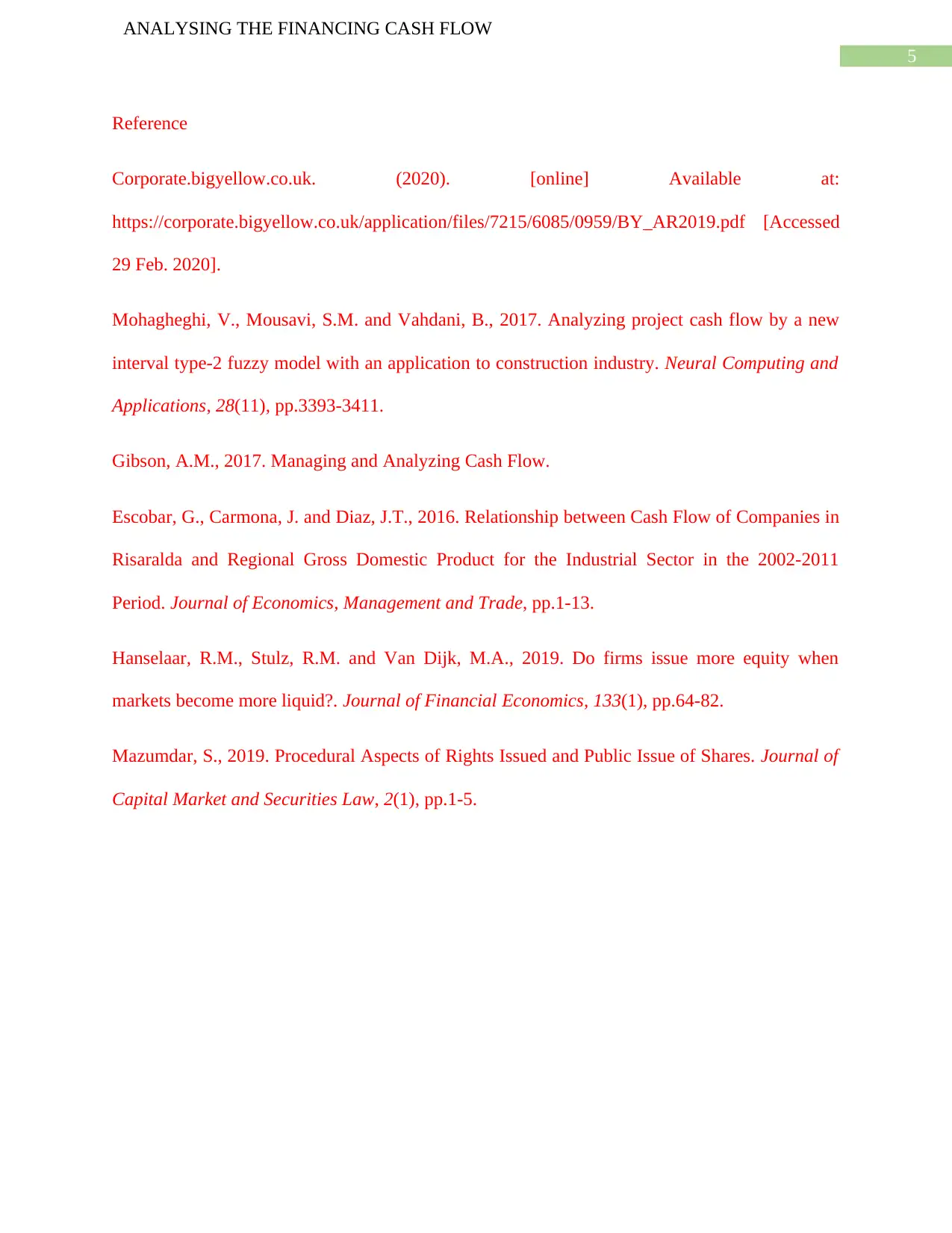
5
ANALYSING THE FINANCING CASH FLOW
Reference
Corporate.bigyellow.co.uk. (2020). [online] Available at:
https://corporate.bigyellow.co.uk/application/files/7215/6085/0959/BY_AR2019.pdf [Accessed
29 Feb. 2020].
Mohagheghi, V., Mousavi, S.M. and Vahdani, B., 2017. Analyzing project cash flow by a new
interval type-2 fuzzy model with an application to construction industry. Neural Computing and
Applications, 28(11), pp.3393-3411.
Gibson, A.M., 2017. Managing and Analyzing Cash Flow.
Escobar, G., Carmona, J. and Diaz, J.T., 2016. Relationship between Cash Flow of Companies in
Risaralda and Regional Gross Domestic Product for the Industrial Sector in the 2002-2011
Period. Journal of Economics, Management and Trade, pp.1-13.
Hanselaar, R.M., Stulz, R.M. and Van Dijk, M.A., 2019. Do firms issue more equity when
markets become more liquid?. Journal of Financial Economics, 133(1), pp.64-82.
Mazumdar, S., 2019. Procedural Aspects of Rights Issued and Public Issue of Shares. Journal of
Capital Market and Securities Law, 2(1), pp.1-5.
ANALYSING THE FINANCING CASH FLOW
Reference
Corporate.bigyellow.co.uk. (2020). [online] Available at:
https://corporate.bigyellow.co.uk/application/files/7215/6085/0959/BY_AR2019.pdf [Accessed
29 Feb. 2020].
Mohagheghi, V., Mousavi, S.M. and Vahdani, B., 2017. Analyzing project cash flow by a new
interval type-2 fuzzy model with an application to construction industry. Neural Computing and
Applications, 28(11), pp.3393-3411.
Gibson, A.M., 2017. Managing and Analyzing Cash Flow.
Escobar, G., Carmona, J. and Diaz, J.T., 2016. Relationship between Cash Flow of Companies in
Risaralda and Regional Gross Domestic Product for the Industrial Sector in the 2002-2011
Period. Journal of Economics, Management and Trade, pp.1-13.
Hanselaar, R.M., Stulz, R.M. and Van Dijk, M.A., 2019. Do firms issue more equity when
markets become more liquid?. Journal of Financial Economics, 133(1), pp.64-82.
Mazumdar, S., 2019. Procedural Aspects of Rights Issued and Public Issue of Shares. Journal of
Capital Market and Securities Law, 2(1), pp.1-5.
⊘ This is a preview!⊘
Do you want full access?
Subscribe today to unlock all pages.

Trusted by 1+ million students worldwide
1 out of 6
Related Documents
Your All-in-One AI-Powered Toolkit for Academic Success.
+13062052269
info@desklib.com
Available 24*7 on WhatsApp / Email
![[object Object]](/_next/static/media/star-bottom.7253800d.svg)
Unlock your academic potential
Copyright © 2020–2025 A2Z Services. All Rights Reserved. Developed and managed by ZUCOL.





